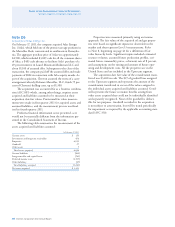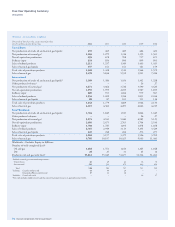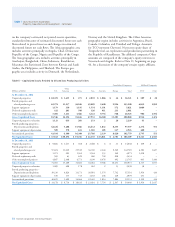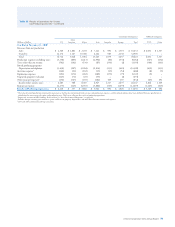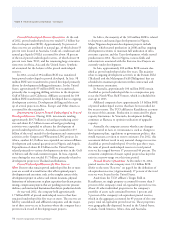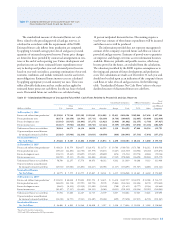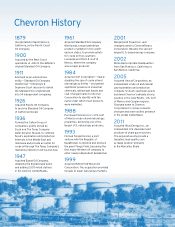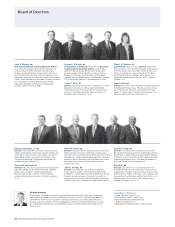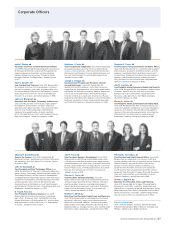Chevron 2012 Annual Report Download - page 79
Download and view the complete annual report
Please find page 79 of the 2012 Chevron annual report below. You can navigate through the pages in the report by either clicking on the pages listed below, or by using the keyword search tool below to find specific information within the annual report.
e RAC has the following primary responsibilities:
establish the policies and processes used within the operat-
ing units to estimate reserves; provide independent reviews
and oversight of the business units’ recommended reserves
estimates and changes; conrm that proved reserves are rec-
ognized in accordance with SEC guidelines; determine that
reserve volumes are calculated using consistent and appro-
priate standards, procedures and technology; and maintain
the Corporate Reserves Manual, which provides standardized
procedures used corporatewide for classifying and reporting
hydrocarbon reserves.
During the year, the RAC is represented in meetings with
each of the company’s upstream business units to review and
discuss reserve changes recommended by the various asset
teams. Major changes are also reviewed with the company’s
Strategy and Planning Committee, whose members include
the Chief Executive Ocer and the Chief Financial Ocer.
e company’s annual reserve activity is also reviewed with the
Board of Directors. If major changes to reserves were to occur
between the annual reviews, those matters would also be dis-
cussed with the Board.
Table V Reserve Quantity Information – Continued
Summary of Net Oil and Gas Reserves
2012*2011*2010*
Liquids in Millions of Barrels
Natural Gas in Billions of Cubic Feet
Crude Oil
Condensate
NGLs
Synthetic
Oil
Natural
Gas
Crude Oil
Condensate
NGLs
Synthetic
Oil
Natural
Gas
Crude Oil
Condensate
NGLs
Synthetic
Oil
Natural
Gas
Proved Developed
Consolidated Companies
U.S. 1,012 –2,574 990 –2,486 1,045 –2,113
Other Americas 91 391 1,063 82 403 1,147 84 352 1,490
Africa 782 –1,163 792 –1,276 830 –1,304
Asia 643 –4,511 703 –4,300 826 –4,836
Australia 31 –682 39 –813 39 –881
Europe 103 –191 116 –204 136 –235
Total Consolidated 2,662 391 10,184 2,722 403 10,226 2,960 352 10,859
Aliated Companies
TCO 977 –1,261 1,019 –1,400 1,128 –1,484
Other 115 50 377 93 50 75 95 53 70
Total Consolidated and Affiliated Companies 3,754 441 11,822 3,834 453 11,701 4,183 405 12,413
Proved Undeveloped
Consolidated Companies
U.S. 347 –1,148 321 –1,160 230 –359
Other Americas 132 122 412 31 120 517 24 114 325
Africa 348 –1,918 363 –1,920 338 –1,640
Asia 194 –2,356 191 –2,421 187 –2,357
Australia 103 –9,570 101 –8,931 49 –5,175
Europe 54 –66 43 –54 16 –40
Total Consolidated 1,178 122 15,470 1,050 120 15,003 844 114 9,896
Affiliated Companies
TCO 755 –1,038 740 –851 692 –902
Other 49 182 865 64 194 1,128 62 203 1,040
Total Consolidated and Affiliated Companies 1,982 304 17,373 1,854 314 16,982 1,598 317 11,838
Total Proved Reserves 5,736 745 29,195 5,688 767 28,683 5,781 722 24,251
* Based on 12-month average price.
RAC subteams also conduct in-depth reviews during
the year of many of the elds that have large proved reserves
quantities. ese reviews include an examination of the
proved-reserve records and documentation of their compli-
ance with the Corporate Reserves Manual.
Technologies Used in Establishing Proved Reserves
Additions In 2012, additions to Chevron’s proved reserves
were based on a wide range of geologic and engineering tech-
nologies. Information generated from wells, such as well logs,
wire line sampling, production and pressure testing, uid
analysis, and core analysis, was integrated with seismic data,
regional geologic studies, and information from analogous
reservoirs to provide “reasonably certain” proved reserves esti-
mates. Both proprietary and commercially available analytic
tools, including reservoir simulation, geologic modeling and
seismic processing, have been used in the interpretation of
the subsurface data. ese technologies have been utilized
extensively by the company in the past, and the company
believes that they provide a high degree of condence in
establishing reliable and consistent reserves estimates.
Chevron Corporation 2012 Annual Report 77



